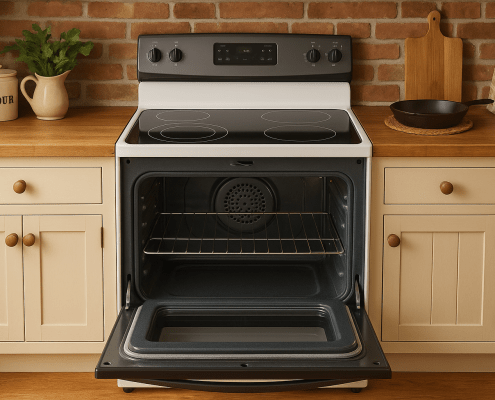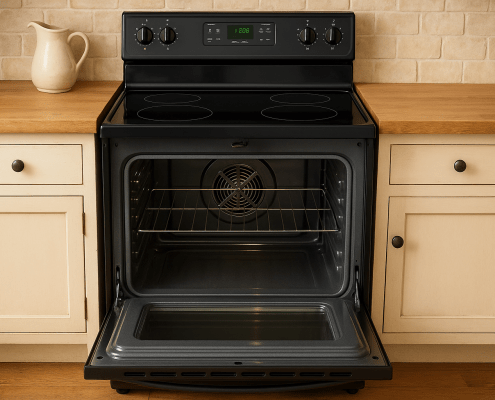How to Replace a Frigidaire Range Igniter and Orifice Assembly
Steven E / Monday April 28, 2025
Is your Frigidaire range leaving you with half-cooked meals due to ignition problems or uneven flames? You’re not alone, and the good news is, fixing a worn-out igniter and orifice assembly is easier than you might think. Dive into our how-to video below and get step-by-step guidance on restoring your range’s performance without having to call in an expensive repair service!
Looking for the right part? Enter your appliance model number below to find the exact match and get your appliance running like new again!
On a Frigidaire range, the igniter and orifice assembly is located underneath the cooktop of the range and includes the gas line that supplies gas to the burner. Over time, the igniter may wear out or the orifice assembly may become clogged, leading to issues with ignition or uneven flame distribution. If you’re experiencing problems with your Frigidaire range, such as difficulty lighting the burners or inconsistent flame patterns, replacing a bad igniter and orifice assembly can resolve these issues. This repair is relatively quick and easy, and with the right tools and following the steps provided, you should be able to complete it within a reasonable amount of time. Let’s get started and restore your Frigidaire range!
Watch here: How To: Frigidaire/Electrolux Igniter and Orifice Assembly 316237805
The information in this article may not apply to your specific appliance model. We recommend consulting your manufacturer’s documentation or contact us with any questions.
Tools needed
- 1/4″ nut driver
- Oil
- Putty knife
- Wrench
- Pliers
Safety precautions
- Always power off and unplug your appliance or switch off the circuit breaker before attempting any maintenance or replacement work. This keeps you safe by preventing any risk of injury from electric shock.
- Turn off the water supply at the outlet before beginning repairs to any appliance parts that hold water. Have towels ready for any residual water in the system when removing parts.
- Wear insulated work gloves to protect your hands from sharp metal parts, pinching hazards and debris.
- Don’t test wiring with a multimeter for live voltage if you’re unfamiliar with how to prevent short circuiting when testing.
- When working with wires, avoid touching any exposed wires or terminals. If you need to touch a wire, use a non-conductive tool or wear insulating gloves to prevent electrical shock.
- Take your time and don’t rush while working to prevent accidents and personal injuries.
- Work in a well-lit area so you can clearly see and access the interior parts.
- Clear your workspace of clutter and other obstacles. Keep children and pets away from the work area.
- Never work on internal parts with bare wet hands. Make sure the work area is completely dry.
- Check your user manual to see if there are specific installation or safety instructions for your part or appliance.
- Be gentle when handling or removing parts. Excessive force might damage the appliance or cause injury.
- Wear safety glasses when working with chemicals, dust or cleaning large debris to prevent injury.
- If the appliance has recently been used, give it plenty of time for any heating parts to cool down before working on it.
Replacement steps
Disassembly
- Remove the grates and burners from the cooktop. Lift them up carefully and set them aside.
- Locate the screws that hold the igniter and orifice assemblies to the range top.
- Use a quarter-inch nut driver to remove the screws. If the screws are tight and difficult to remove, apply some rust removing oil and allow it to soak in for a couple of hours to loosen them.
- After removing all the screws, use a putty knife to release the clips located about four inches from each corner of the cooktop.
- With both clips released, lift the front of the cooktop up and carefully remove it from the range. Set it aside.
- With the cooktop removed, you will now have access to the igniter assemblies.
Installation
- Start by connecting the wire to the new igniter assembly so that the locking mechanism is secure.
- Line up the gas line of the new igniter assembly and hand-tighten the half-inch nut onto the gas valve.
- Use a wrench to tighten the nut securely, ensuring a good seal. While tightening, keep the orifice assembly level to prevent it from being pulled over.
- Once the new assembly is installed, carefully align the range top and lower it into position. Make sure that the orifice assemblies protrude through their respective openings.
- Snap the range top back into place and reinstall the screws using the quarter-inch nut driver. If any igniter and orifice assembly is not aligned properly, gently adjust it with pliers before screwing it in place.
- Reinstall the burners and caps. Make sure that the openings of the burners align with the igniters. Place each burner down and then put the cap on top.
- Repeat the process for the remaining burners.
- Replace the grates on the cooktop. Turn the gas back on and check for any gas leaks. Plug the range back in and test it to make sure that everything is working correctly.
Additional information
Thanks for reading! We hope this guide helped you replace the igniter and orifice assembly on your Frigidaire range.
If you still need some replacement parts, grab your model number and head over to AppliancePartsPros.com. We offer over two million parts and most orders arrive in two business days. If you need some help with finding the right part or placing an order, you can contact our team at 1 (877) 477-7278.
While you’re waiting for your new part to arrive, you can explore our DIY blog and watch thousands of video tutorials on our YouTube channel.
Be sure to follow us on Facebook, Twitter and Instagram to see our latest repair guides!
With nearly a decade of experience in providing top-notch customer service regarding appliance parts and repair, Steven enjoys sharing practical advice, troubleshooting tips, and interesting information to help readers stay informed.





